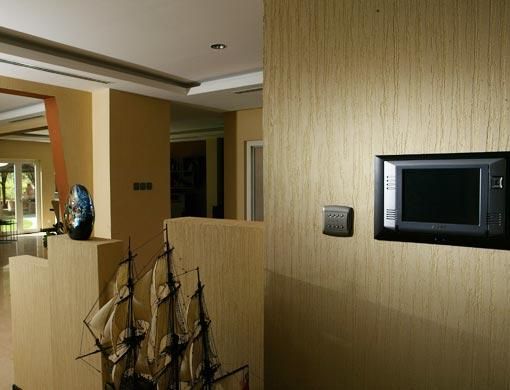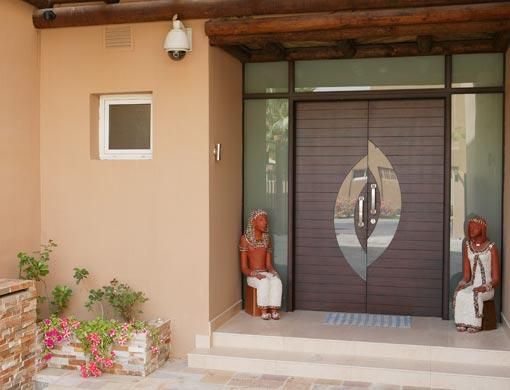A flick of a button or a tap on a touchscreen can pull off the most stupendous feats.
It can, if you experience home automation, get a fridge to take an inventory of expired items, a coffeemaker to brew at a certain time and a microwave to heat food before you reach home.
It can allow remote security control through IP (Internet Protocol) cameras that will send you an SMS in case of a break-in and alert the police or security. And if you want to deceive intruders when you're away, make the lights flicker at night so the house looks occupied.
Till a few years ago, these futuristic elements seemed farfetched. The images of intelligent appliances and appurtenances were relegated to movies like Minority Report, Aeon Flux, Demolition Man, Gattaca and Click. Today these are documentary material.
Access to technology has become a simple exercise in finger callisthenics.
Home automation, referred as SH or Smart Homes, can automate basic and sophisticated tasks and integrate control functions through wired or wireless touch panel displays.
Leon Beuyukian, co-founder and CEO of EON, a retail digital and home automation store in the UAE, calls the concept a lifestyle, modus vivendi of the modern person.
For those with a predilection for ambitious living, he says Smart Homes introduce quality and security. "When you automate tasks, you free up time to enjoy important aspects of your life. Centralised control enables mobility, increases multimedia capability and conserves energy."
In principle, the concept promotes simplicity and control. Ironically, it is often faced with spurious assumptions in areas of compatibility, pricing and connectivity quite contrary to its design philosophy.
Smart Homes: an informed decision
The megalomania surrounding Smart Homes isn't new; the technology has existed for about 15 years. However, it has only recently achieved universal applicability and acceptance. One reason is the standardised network communications protocol that is independent of hardware platforms. (Prior manufacturers used proprietary technology.)
"The problem earlier was lack of connectivity between brands that forced customers to buy from one manufacturer. Standardised protocol changed this.
Now different brands of electronics and appliances are able to communicate with each other and perform a variety of tasks. This coupled with the development of the real estate industry, in general, has fuelled a demand for Smart Homes," says Leon.
EON stores allow system integration through products from GE Security, SIEMENS, Intel, Microsoft, LG, AMX, Linksys, NIKO, Bticino, Legrand, Logitech, HP, Dell, Philips, Sony, Netgear, Toshiba, Panasonic, Sony VAIO, Crestron and Samsung. Thus allowing a customer to choose
based on preference, brand loyalty and cost.
The putative notions of high pricing – associated with home automation – have changed too. Smart Homes, depending on size and infrastructure, costs between Dh50,000 to Dh150,000 and upwards to install. This is three times cheaper than before.
Leon imputes the reduced cost to the confluence of technological breakthroughs like embedded chips, digital convergence, continuous broadband and improved infrastructure.
"Wireless technology and broadband have made remote management efficient and possible. Internet usage used to be limited in the past."
Smart Homes, though marketed as a high-end solution, is customisable. Some customers select products for surveillance so they can monitor their children and nannies. Some install superior audio and video products for entertainment. Others invest in household management of domestic appliances to save time and obviate the need for househelp.
"Customers don't have to incorporate all the five categories available under Smart Homes. An average income person may want to start with one category," he says.
The five categories
Smart Homes have five broad categories. These are divided into audio-video distribution; security and surveillance; energy and household management; intelligent lighting and integrated controls.
The security segment has IP cameras, access control, mobility solutions and intrusion detection features. Energy and household management automates water (taps, sprinklers), lighting, climate control, gas and water leakage. Intelligent lighting allows you to dim and increase lights to set a mood. And integrated controls provide access to remote
and touch panels.
"Our top-selling categories are audio-video distribution followed by security and surveillance," says Leon.
The technology behind Smart Homes
A home automation system can connect the oven, fridge, washing machine, dishwasher, television, music system, central heating, lighting, security system, gas, electricity, water and the internet.
A concatenation of technologies including broadband, wireless, radio frequency (RF), touch panels, embedded microprocessors and microcontrollers is necessary for a fully automated home. Various sensors measure thermal, optical, chemical, mechanical and magnetic activity and actuators control movement, positioning, pumping and filtering
in a home.
"These technologies work in conjunction with each other,"
says Leon.
The hardware (appliances) too has to work with each other through a server, he says. "To establish connectivity various brands must talk the same language or adhere to a standard known as KNX."
Smart Homes uses a universal standard called KNX set by Belgium-based KNX Association. It is a standard for all applications in home and building controls, ranging from lighting to security and energy management.
"KNX-certified products [more than 70,000 worldwide] guarantee system compatibility, interworking and interoperability. A network based on KNX can be controlled by anything from an eight-bit microcontroller to
a PC," he says.
The celerity of technology has resulted in several points of accessibility, from laptops to PDAs and touch panels. Leon says mobile, along with wireless and broadband technology combine to ensure a homeowner is connected 24/7.
Smart Homes also enables self-diagnostics. Troubleshooting and malfunctioning networks are immediately reported to the owner and retailer or service provider. And though this becomes a "privacy issue,
a retailer will always ask for the customer's permission before conducting any repair or maintenance work".
Set up
It's interesting to note that despite the predominance of Smart Homes in the property market, there is a paucity of knowledge and technical expertise.
The fight against nescience has to be initiated by property developers and retailers. At a retail level, the challenge is to educate customers about technology and address their fears and concerns on connectivity between brands.
"Our sales advisers and consultants are trained to do this. Luckily most people are tech savvy. We reiterate information on system integration and compatibility," says Leon.
In the UAE, developers sell properties that are "Smart Homes" ready. This means the infrastructure has the required cabling and access points.
(EON is currently working with Fakhruddin Properties and three renowned developers in the region. One of its projects is to enhance a floating architectural concept of a building through automation and
light controls.)
The installation of smart technology in existing homes poses more infrastructure problems and often requires rewiring. "It is better to work with a new home before the MEP [mechanical, electrical and plumbing] stage. Structured wiring enables the installation of home technology systems. Then you can decide what you want to integrate.
It is also cost-effective." Having said that, Leon says wireless technology has made it easier to work with existing homes without invasive modifications. A contract for home automation starts with a consultation to ascertain the needs of the customer. This is followed by a survey at the residence to work out details of available space, the number of rooms and floors and width of the walls for cabling. Then, depending on the size, installation can take a few days or even up to a week.
The concerns
One question Leon is asked most often is: "Can we dismantle the automation system and take it back with us?"
This is because the UAE, with its large expatriate population, is often considered a temporary home. Many choose to return to their home countries or migrate.
"I tell customers that an investment in Smart Homes is not geographically bound. Since most of the technology is wireless, it can be used anywhere in the world," he says.
The other concern is the upgrade factor. To this, Leon says, "When I first propound the idea of home automation, I tell them that it depends on what they want and how far or how many functions they want to automate. We can then choose accordingly. A customer can buy a universal remote control for audio and video and after a few months, add security options."
Security of the network, though not an issue with most customers, is often addressed by those investing in security and surveillance. "We enable the protection through firewalls and other electronic safety nets. Smart Homes is a safe network unless connected to the internet. Here again, we ensure optimum safety."
Though Smart Homes can link your household appliances and home security features into a wider network that includes security firms or police stations, "this is not the case in the UAE at this stage. A few developers are experimenting with it."
Carolina D'Souza is Lifestyle Features Coordinator, Friday





